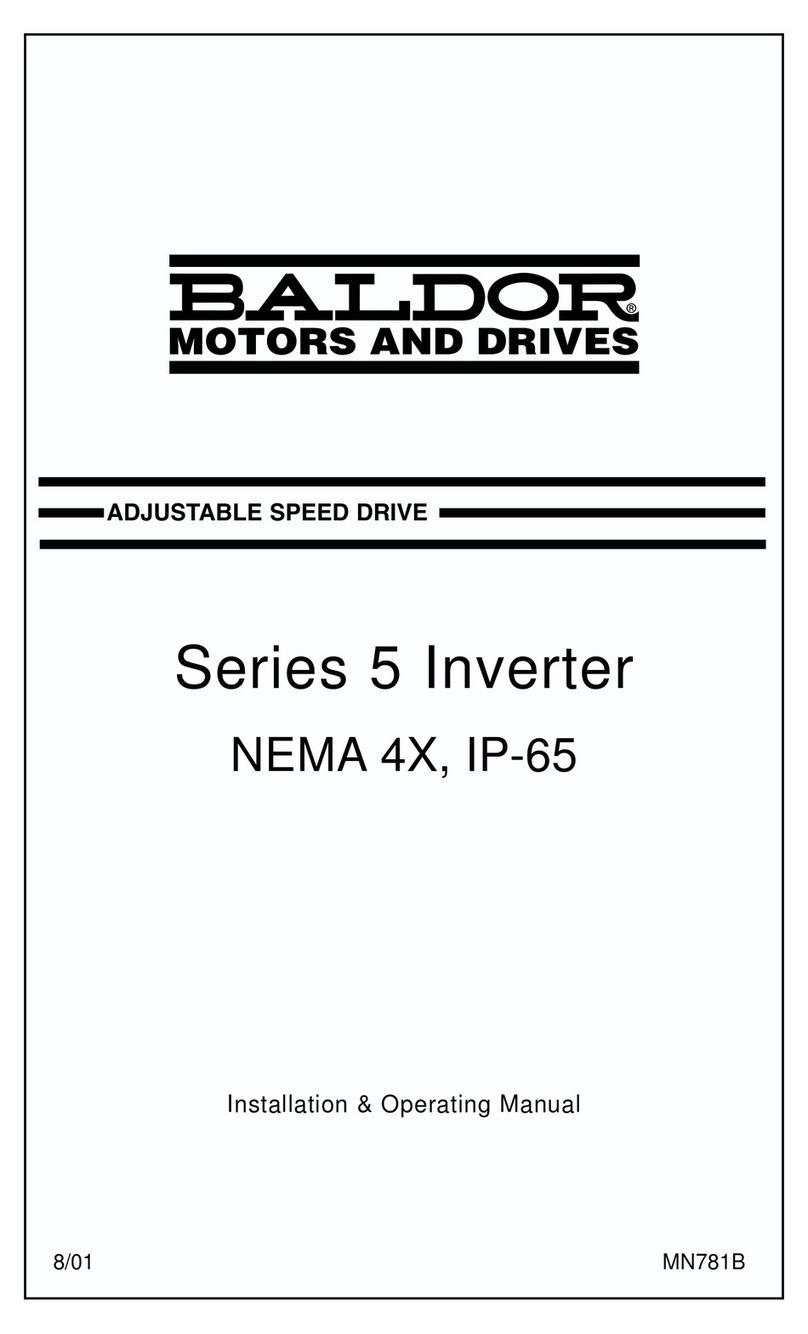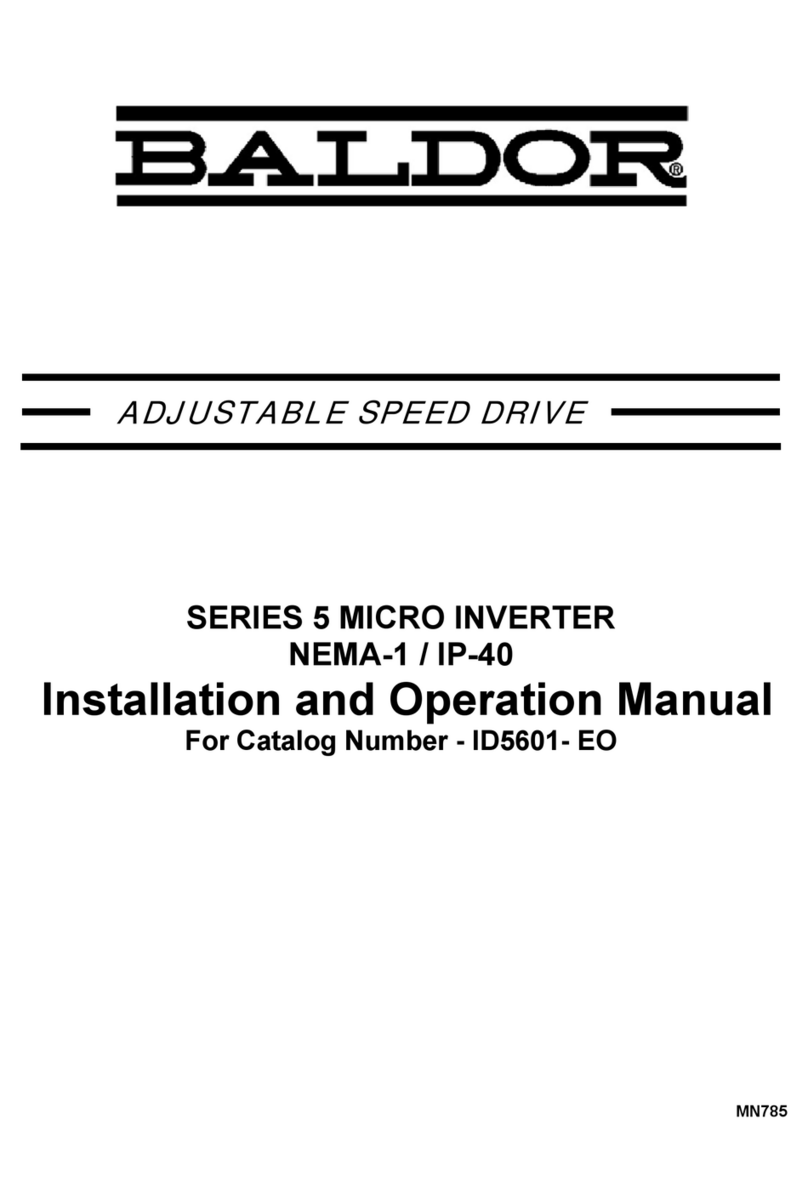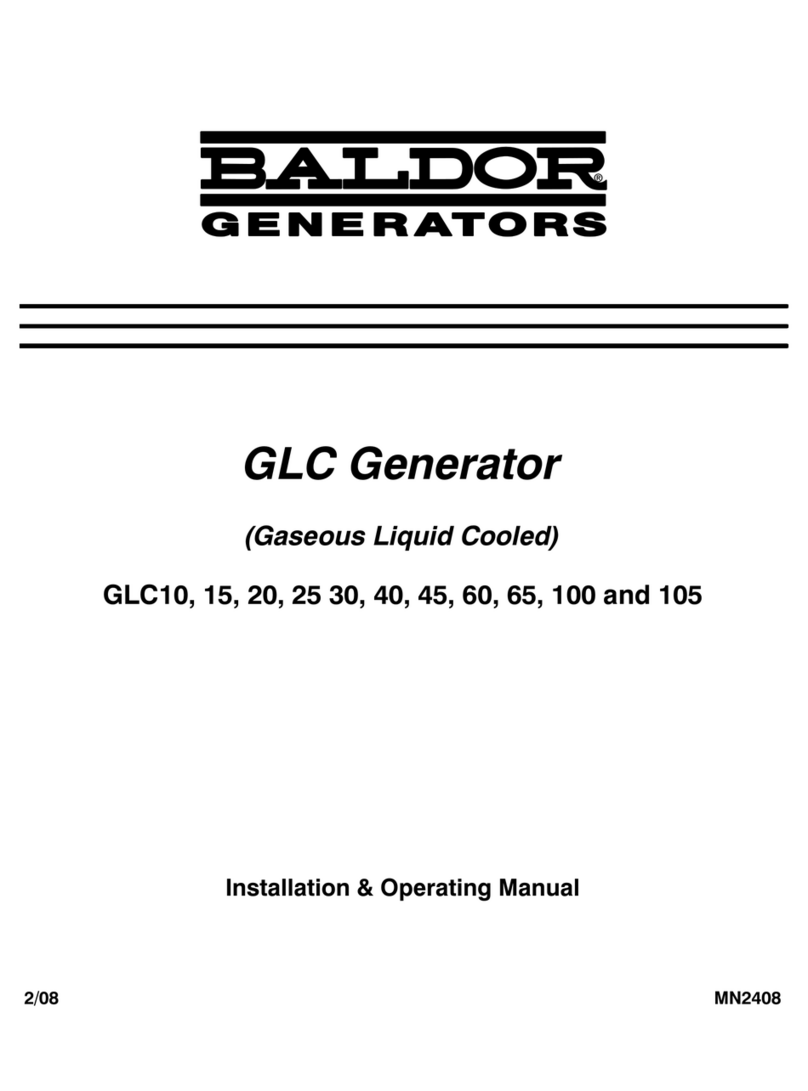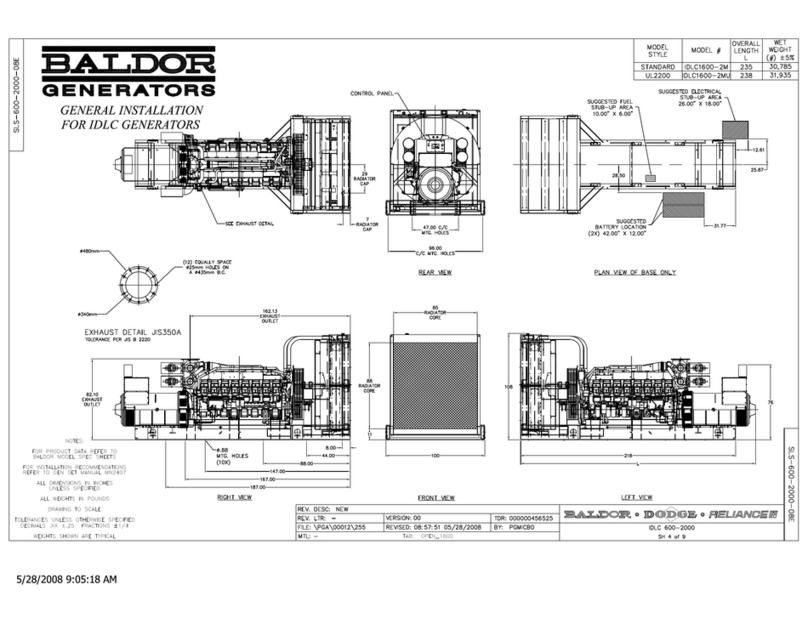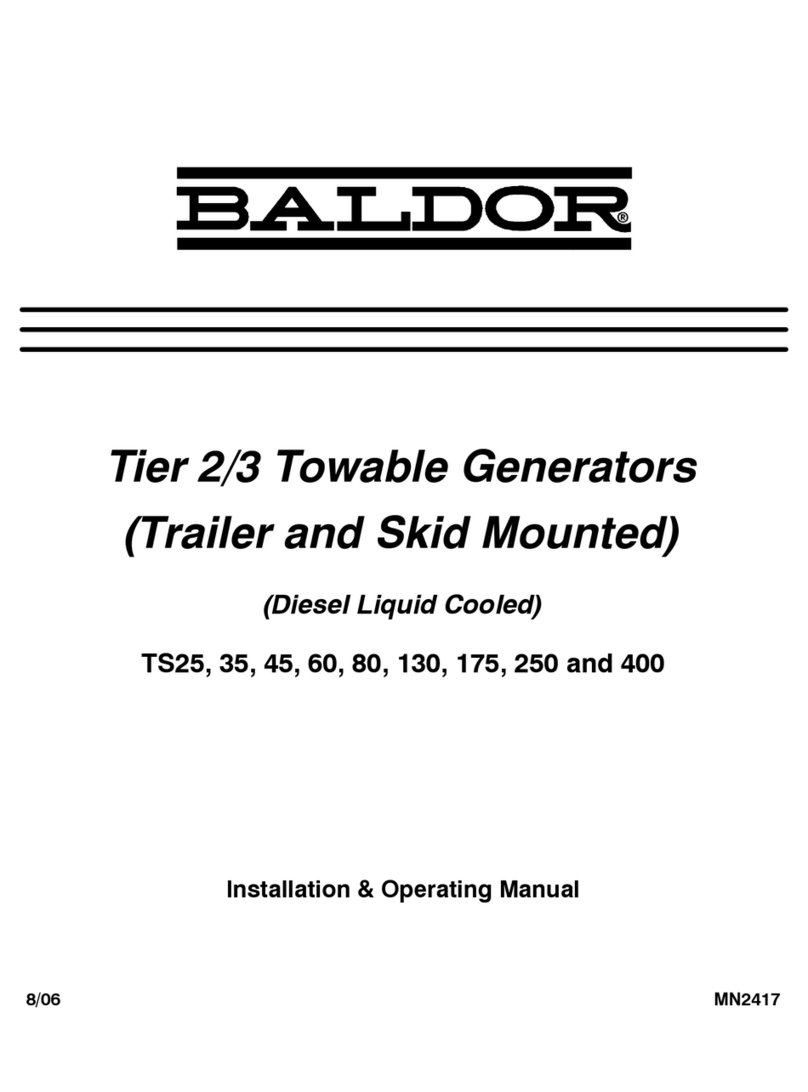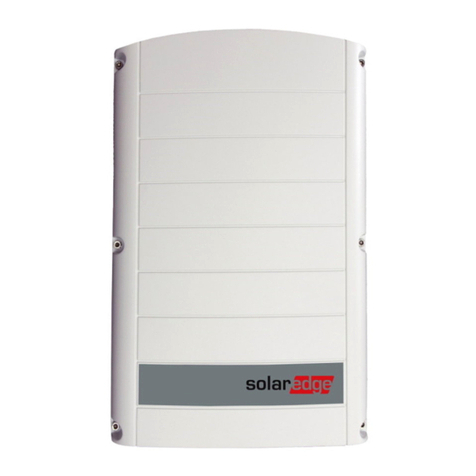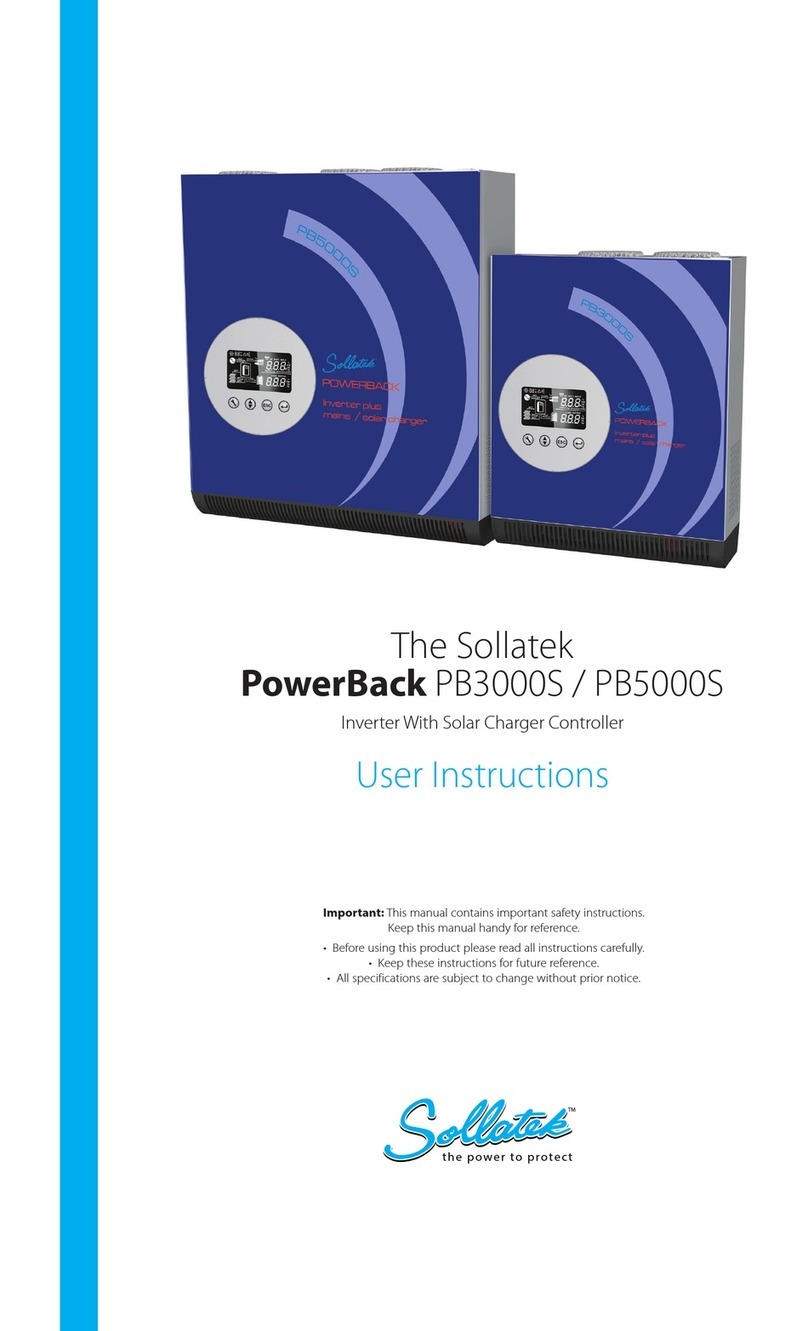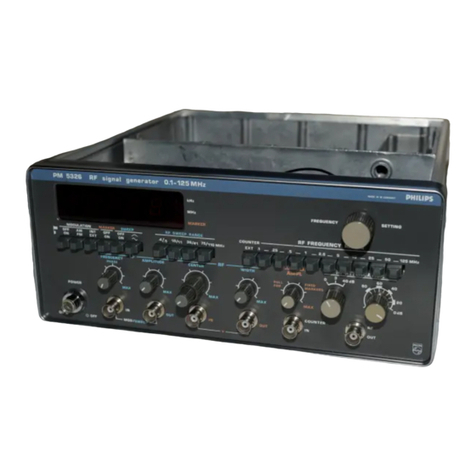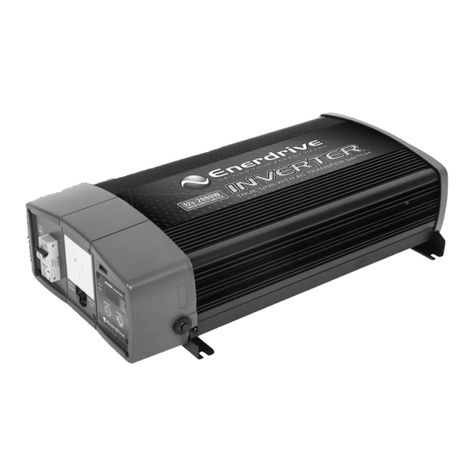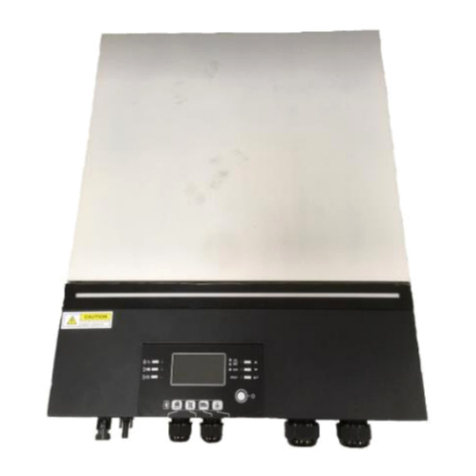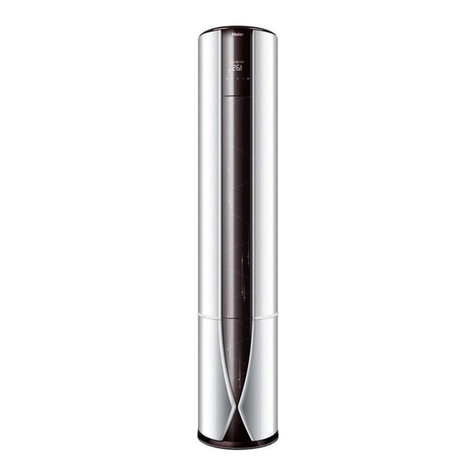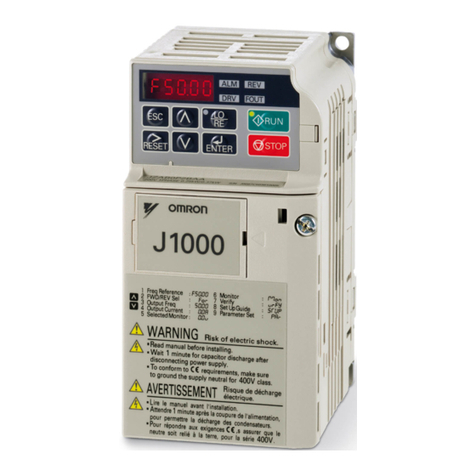Baldor MN427 User manual

BALDOR MN427 Inverter Duty PM Motors Manual
http://www.manuallib.com/baldor/mn427-inverter-duty-pm-motors-manual.html
This instruction manual is not intended to include a comprehensive listing of all details for all
procedures required for installation, operation and maintenance. This manual describes general
guidelines that apply to most of the motor products shipped by Baldor. If you have a question
about a procedure or are uncertain about any detail, Do Not Proceed.
Please contact your Baldor District office for more information or clarification.
Before you install, operate or perform maintenance, become familiar with the following if applicable to
your area:
NEMA Publication MG-2, Safety Standard for Construction and guide
for Selection, Installation and Use of Electric Motors and Generators.
IEC 34−1 Electrical and IEC72−1 Mechanical specifications
ANSI C51.5, the National Electrical Code (NEC) and local codes and practices.
ManualLib.com collects and classifies the global product
instrunction manuals to help users access anytime and
anywhere, helping users make better use of products.
http://www.manuallib.com

Table of Contents
Table of Contents iMN427
Section 1
General Information 1−1...............................................................................
Overview 1−1.....................................................................................
Limited Warranty 1−1...............................................................................
Safety Notice 1−1..................................................................................
Receiving 1−3.....................................................................................
Handling 1−3......................................................................................
Storage 1−3.......................................................................................
Section 2
Installation & Operation 2−1...........................................................................
Overview 2−1.....................................................................................
Mechanical Installation 2−1.........................................................................
Mounting Location 2−1.........................................................................
Alignment 2−2.....................................................................................
Guarding 2−3.....................................................................................
Electrical Installation 2−3...........................................................................
Thermostat Leads Connection 2−3..............................................................
Grounding 2−4................................................................................
Condensation Drain 2−4........................................................................
Fan Mounting 2−4.................................................................................
Bearing Axial Thrust Limits 2−5......................................................................
Optional Accessories 2−5...........................................................................
First Time Start Up and Operation 2−6................................................................
Air Flow Cooling 2−6...............................................................................
Maximum Safe Speed 2−6......................................................................
Balance 2−6..................................................................................
Section 3
Maintenance & Troubleshooting 3−1....................................................................
General Inspection 3−1.............................................................................
Relubrication & Bearings 3−1........................................................................
Lubrication Procedure 3−1......................................................................
Interval and Type of Grease 3−2.................................................................
Troubleshooting Chart 3−3..........................................................................
Suggested bearing and winding RTD setting guidelines for Non−Hazardous Locations ONLY 3−4............
This Manual:http://www.manuallib.com/baldor/mn427-inverter-duty-pm-motors-manual.html

Section 1
General Information
General Information 1−1MN427
Overview This manual contains general procedures that apply to BaldorSReliance Cooling Tower PM Motor products.
Be sure to read and understand the Safety Notice statements in this manual. For your protection, do not
install, operate or attempt to perform maintenance procedures until you understand the Warning and
Caution statements.
A Warning statement indicates a possible unsafe condition that can cause harm to personnel.
A Caution statement indicates a condition that can cause damage to equipment.
Important: This instruction manual is not intended to include a comprehensive listing of all details for all
procedures required for installation, operation and maintenance. This manual describes general
guidelines that apply to most of the motor products shipped by Baldor. If you have a question
about a procedure or are uncertain about any detail, Do Not Proceed.
Please contact your Baldor District office for more information or clarification.
Before you install, operate or perform maintenance, become familiar with the following if applicable to
your area:
SNEMA Publication MG-2, Safety Standard for Construction and guide
for Selection, Installation and Use of Electric Motors and Generators.
SIEC 34−1 Electrical and IEC72−1 Mechanical specifications
SANSI C51.5, the National Electrical Code (NEC) and local codes and practices.
Limited Warranty
www.baldor.com/support/warranty_standard.as
Safety Notice: This equipment contains high voltage! Electrical shock can cause serious or fatal injury.
Only qualified personnel should attempt installation, operation and maintenance of electrical equipment.
Be sure that you are completely familiar with NEMA publication MG-2, safety standards for construction and
guide for selection, installation and use of electric motors and generators, the National Electrical Code and
local codes and practices. Unsafe installation or use can cause conditions that lead to serious or fatal injury.
Only qualified personnel should attempt the installation, operation and maintenance of this equipment.
WARNING: Do not touch electrical connections before you first ensure that power has been disconnected.
Electrical shock can cause serious or fatal injury. Only qualified personnel should attempt the
installation, operation and maintenance of this equipment.
WARNING: Disconnect all electrical power from the motor windings and accessory devices before
disassembly of the motor. Electrical shock can cause serious or fatal injury.
WARNING: The Adjustable Speed Controller may apply hazardous voltages to the motor leads after power to
the controller has been turned off. Verify that the controller is incapable of delivering hazardous
voltages and that the voltage at the motor leads is zero before proceeding. Failure to observe this
precaution may result in severe bodily injury or death.
WARNING: Be sure the system is properly grounded before applying power. Do not apply AC power before
you ensure that all grounding instructions have been followed. Electrical shock can cause
serious or fatal injury. National Electrical Code and Local codes must be carefully followed.
WARNING: Avoid extended exposure to machinery with high noise levels. Be sure to wear ear protective
devices to reduce harmful effects to your hearing.
WARNING: Surface temperatures of motor enclosures may reach temperatures which can cause discomfort
or injury to personnel accidentally coming into contact with hot surfaces. When installing,
protection should be provided by the user to protect against accidental contact with hot surfaces.
Failure to observe this precaution could result in bodily injury.
WARNING: This equipment may be connected to other machinery that has rotating parts or parts that are
driven by this equipment. Improper use can cause serious or fatal injury. Only qualified
personnel should attempt to install operate or maintain this equipment.
WARNING: Do not by-pass or disable protective devices or safety guards. Safety features are designed to
prevent damage to personnel or equipment. These devices can only provide protection if they
remain operative.
WARNING: Avoid the use of automatic reset devices if the automatic restarting of equipment can be
hazardous to personnel or equipment.
WARNING: Be sure the load is properly coupled to the motor shaft before applying power. The shaft key
must be fully captive by the load device. Improper coupling can cause harm to personnel or
equipment if the load decouples from the shaft during operation.
This Manual:http://www.manuallib.com/baldor/mn427-inverter-duty-pm-motors-manual.html

Section 1
General Information
1−2 General Information MN427
Safety Notice Continued
WARNING: Mechanically lock or tie down the fan to prevent rotation as voltage will be produced even when
the PM motor is totally disconnected from the power source.
WARNING: Use proper care and procedures that are safe during handling, lifting, installing, operating and
maintaining operations. Improper methods may cause muscle strain or other harm.
WARNING: Incorrect motor rotation direction can cause serious or fatal injury or equipment damage. Be sure
to verify motor rotation direction before coupling the load to the motor shaft.
WARNING: Motors that are to be used in flammable and/or explosive atmospheres must display the CSA
listed logo. Specific service conditions for these motors are defined in NFPA 70 (NEC) Article 500.
WARNING: Pacemaker danger −Magnetic and electromagnetic fields in the vicinity of current carrying
carrying conductors and permanent magnet motors can result result in a serious health hazard to
persons with cardiac pacemakers, metal implants, and hearing aids. To avoid risk, stay way from
the area surrounding a permanent magnet motor.
WARNING: RPM AC permanent magnet motors can induce voltage and current in the motor leads by rotating
the motor shaft. Electrical shock can cause serious or fatal injury. Therefore, do not couple the
load to the motor shaft until all motor connections have been made. During any maintenance
inspections, be sure the motor shaft will not rotate.
WARNING: Before performing any motor maintenance procedure, be sure that the equipment connected to
the motor shaft cannot cause shaft rotation. If the load can cause shaft rotation, disconnect the
load from the motor shaft before maintenance is performed. Unexpected mechanical rotation of
the motor parts can cause injury or motor damage.
WARNING: Do not use non UL/CSA listed explosion proof motors in the presence of flammable or
combustible vapors or dust. These motors are not designed for atmospheric conditions that
require explosion proof operation.
WARNING: UL Listed motors must only be serviced by UL Approved Authorized Baldor Service Centers if
these motors are to be returned to a hazardous and/or explosive atmosphere.
WARNING: Guards must be installed for rotating parts such as couplings, pulleys, external fans, and unused
shaft extensions, should be permanently guarded to prevent accidental contact by personnel.
Accidental contact with body parts or clothing can cause serious or fatal injury.
Caution: Use only a shielded motor power cable with a complete circumferential braided or copper
film/tape ground jacket around the power leads. This ground should be secured to the motor
frame from within the motor terminal box and must return without interruption to the drive ground.
In addition, if the motor and coupled equipment are not on a single common metal base plate, it is
important to equalize the equipment ground potentials by bonding the motor frame to the coupled
equipment using a high frequency conductor such as a braided strap.
Caution: Do not lift the motor and its driven load by the motor lifting hardware. The motor lifting hardware
is adequate for lifting only the motor. Disconnect the load (gears, pumps, compressors, or other
driven equipment) from the motor shaft before lifting the motor.
Caution: Do not lift the motor by the shaft. The motor is designed to drive a load but it is not intended to
have lifting forces and stresses applied to the motor shaft. Damage to the motor may result.
Caution: If eye bolts are used for lifting a motor, be sure they are securely tightened. The lifting direction
should not exceed a 20angle from the shank of the eye bolt or lifting lug. Excessive lifting
angles can cause damage.
Caution: To prevent equipment damage, be sure that the electrical service is not capable of delivering more
than the maximum motor rated amps listed on the rating plate.
Caution: If a HI POT test (High Potential Insulation test) must be performed, follow the precautions and
procedure in NEMA MG1 and MG2 standards to avoid equipment damage.
Caution: Do not use an induction oven to heat noise tested bearings. Arcing between the balls and races
may damage the bearing. Failure to observe this precaution may result in equipment damage.
If you have any questions or are uncertain about any statement or procedure, or if you require additional
information please contact your Baldor District office or an Authorized Baldor Service Center.
This Manual:http://www.manuallib.com/baldor/mn427-inverter-duty-pm-motors-manual.html

General Information 1−3MN427
Receiving Each BaldorSReliance motor is thoroughly tested at the factory and carefully packaged for shipment.
When you receive your motor, there are several things you should do immediately.
1. Observe the condition of the shipping container and report any damage immediately to the
commercial carrier that delivered your motor.
2. Verify that the part number of the motor you received is the same as the part number listed on your
purchase order.
Handling The motor should be lifted using the lifting lugs or eye bolts provided.
1. Use the lugs or eye bolts provided to lift the motor. Never attempt to lift the motor and additional
equipment connected to the motor by this method. The lugs or eye bolts provided are designed to lift
only the motor. Never lift the motor by the motor shaft or the hood of a WPII motor. If eye bolts are
used for lifting a motor, be sure they are securely tightened. The lifting direction should not exceed a
20angle from the shank of the eye bolt. Excessive lifting angles can cause motor damage.
2. To avoid condensation inside the motor, do not unpack until the motor has reached room temperature.
(Room temperature is the temperature of the room in which it will be installed). The packing provides
insulation from temperature changes during transportation.
Storage Storage requirements for motors and generators that will not be placed in service for at least six months
from date of shipment. Improper motor storage will result in seriously reduced reliability and failure.
An electric motor that does not experience regular usage while being exposed to normally humid
atmospheric conditions is likely to develop rust in the bearings or rust particles from surrounding surfaces
may contaminate the bearings. The electrical insulation may absorb an excessive amount of moisture
leading to the motor winding failure.
A wooden crate “shell” should be constructed to secure the motor during storage. This is similar to an
export box but the sides & top must be secured to the wooden base with lag bolts (not nailed as export
boxes are) to allow opening and closing many times without damage to the “shell”.
Minimum resistance of motor winding insulation is 5 Meg ohms or the calculated minimum, which ever is
greater. Minimum resistance is calculated as follows: Rm = kV + 1
where: (Rm is minimum resistance to ground in Meg−Ohms and
kV is rated nameplate voltage defined as Kilo−Volts.)
Example: For a 480VAC rated motor Rm =1.48 meg−ohms (use 5 M).
For a 4160VAC rated motor Rm = 5.16 meg−ohms.
Preparation for Storage
1. Some motors have a shipping brace attached to the shaft to prevent damage during transportation.
The shipping brace, if provided, must be removed and stored for future use. The brace must be
reinstalled to hold the shaft firmly in place against the bearing before the motor is moved.
2. Store in a clean, dry, protected warehouse where control is maintained as follows:
a. Shock or vibration must not exceed 2 mils maximum at 60 hertz, to prevent the bearings from
brinelling. If shock or vibration exceeds this limit vibration isolation pads must be used.
b. Storage temperatures of 10C (50F) to 49C (120F) must be maintained.
c. Relative humidity must not exceed 60%.
d. Motor space heaters (when present) are to be connected and energized whenever there is a
possibility that the storage ambient conditions will reach the dew point. Space heaters are
optional.
Note: Remove motor from containers when heaters are energized, reprotect if necessary.
3. Measure and record the resistance of the winding insulation (dielectric withstand) every 30 days of
storage.
a. If motor insulation resistance decreases below the minimum resistance, contact your Baldor
District office.
b. Place new desiccant inside the vapor bag and re−seal by taping it closed.
This Manual:http://www.manuallib.com/baldor/mn427-inverter-duty-pm-motors-manual.html

1−4 General Information MN427
c. If a zipper−closing type bag is used instead of the heat−sealed type bag, zip the bag closed
instead of taping it. Be sure to place new desiccant inside bag after each monthly inspection.
d. Place the shell over the motor and secure with lag bolts.
4. Where motors are mounted to machinery, the mounting must be such that the drains and breathers
are fully operable and are at the lowest point of the motor. Vertical motors must be stored in the
vertical position. Storage environment must be maintained as stated in step 2.
5. Cooling Tower Motors have anti−friction bearings that are fully greased at the time of shipment from
the factory and suitable for going into extended storage with periodic service as follows:
a. Motors marked “Do Not Lubricate” on the nameplate do not need to be greased before or during
storage.
b. Ball bearing (anti−friction) motor shafts are to be rotated manually every six months and greased
in accordance with the Maintenance section of this manual.
6. All breather drains are to be fully operable while in storage (drain plugs removed). The motors must
be stored so that the drain is at the lowest point. All breathers and automatic “T” drains must be
operable to allow breathing and draining at points other than through the bearings around the shaft.
Vertical motors should be stored in a safe stable vertical position.
7. Coat all external machined surfaces with a rust preventing material.
An acceptable product for this purpose is Exxon Rust Ban # 392.
Removal From Storage
1. Remove all packing material.
2. Measure and record the electrical resistance of the winding insulation resistance meter at the time of
removal from storage. The insulation resistance must not be less than 50% from the initial reading
recorded when the motor was placed into storage. A decrease in resistance indicates moisture in the
windings and necessitates electrical or mechanical drying before the motor can be placed into
service. If resistance is low, contact your Baldor District office.
3. Regrease the bearings as instructed in Section 3 of this manual.
4. Reinstall the original shipping brace if motor is to be moved. This will hold the shaft firmly against the
bearing and prevent damage during movement.
This Manual:http://www.manuallib.com/baldor/mn427-inverter-duty-pm-motors-manual.html

Section 2
Installation & Operation
Installation & Operation 2−1MN427
Overview Installation should conform to the National Electrical Code as well as local codes and practices. When
other devices are coupled to the motor shaft, be sure to install protective devices to prevent future
accidents. Some protective devices include, coupling, belt guard, chain guard, shaft covers etc. These
protect against accidental contact with moving parts. Machinery that is accessible to personnel should
provide further protection in the form of guard rails, screening, warning signs etc.
RPM ACtCooling Tower PM motors are high performance motors specifically designed for use with
adjustable frequency controllers. The basic design includes Class H insulation, 1.0 service factor, 40C
ambient, continuous duty. Standard enclosure is totally enclosed air over (TEAO) with minimum
recommended air flow velocities provided by the application fan. Many modifications, and accessories are
available. Motors are permanent magnet rotor construction. Refer to the motor nameplate or the
performance data sheet for the rated air velocity.
Motors are designed exclusively for outdoor cooling tower environments. Rated air flow is required for
proper operation. Motors are designed to mount inside the cooling tower with the fan mounted directly to
the motor shaft.
Mechanical Installation
Caution: Do not lift the motor and its driven load by the motor lifting hardware. The motor lifting hardware
is adequate for lifting only the motor. Disconnect the fan from the motor shaft before lifting the
motor.
Caution: Do not lift the motor by the shaft. The motor is designed to drive a load but it is not intended to
have lifting forces and stresses applied to the motor shaft. Damage to the motor may result.
Caution: If eye bolts are used for lifting a motor, be sure they are securely tightened. The lifting direction
should not exceed a 20angle from the shank of the eye bolt or lifting lug. Excessive lifting
angles can cause damage.
After storage or after unpacking and inspection to see that all parts are in good condition, do the following:
1. Rotate the motor shaft by hand to be sure there are no obstructions to free rotation.
2. A motor that has been in storage for some time should be tested for moisture (dielectric withstand
insulation test) and relubricated (regreasable type) prior to being put into service.
3. A motor with roller bearings is shipped with a shaft block. After removing the shaft block, be sure to
replace any bolts used to hold the shaft block in place during shipment that are required in service.
Table 2−1 Tightening Torque
NEMA Frame Hole Dia.
(Inch)
Bolt Size
& Thread
Torque lb−ft
for Bolt Grade
SAE 5 SAE 8
FL250Y 0.69 5/8 −11 155−176 200−249
FL280Y 0.69 5/8 −11 155−176 200−249
FL440Y 0.81 3/4 −10 274−310 389−440
FL5800Y 1.06 7/8 −9 434−486 616−689
Mounting Location
All RPM AC cooling tower motors are designed to be mounted vertical, shaft up, supported by the
opposite drive end bracket. Use appropriate hardware (not furnished).
The motor should be installed in a location compatible with the motor enclosure required air flow and
specific ambient.
The motor must be securely installed to a rigid foundation or mounting surface to minimize vibration and
maintain alignment between the motor and fan blades within the cooling tower walls. Failure to provide a
proper mounting surface may cause vibration, misalignment and bearing damage. All hold down bolts
must be the correct grade for the type of mounting and must be torqued to their recommended value.
Foundation caps and sole plates are designed to act as spacers for the equipment they support. If these
devices are used, be sure that they are evenly supported by the foundation or mounting surface.
When installation is complete and accurate alignment of the motor and fan is accomplished, the base
should be grouted to the foundation to maintain this alignment.
The standard motor base is designed for vertical mounting.
This Manual:http://www.manuallib.com/baldor/mn427-inverter-duty-pm-motors-manual.html

2−2 Installation & Operation MN427
Installation Procedure:
1. Verify that the motor shaft is compatible with fan hub design and that the planned mounting surface is
compatible with the opposite drive end flange mounting hole configuration.
2. Verify that the fan is properly balanced prior to lowering down onto the motor shaft.
3. Follow all safety lock out and tag out procedures for confined space installation.
4. Ensure that the cooling tower motor mounting surface is flat and mechanically suitable for the cooling
tower motor flange mounting.
5. Lower the motor in place using the four motor eye bolts.
6. Level the motor with respect to the base. Use a dial indicator on top of the motor feet and verify that
foot deflection does not exceed 0.005 in (0.125 mm) as the mounting bolts are tightened.
7. Shims should be used under motor feet to prevent excessive deflection that causes permanent
deformation of the motor feet.
8. Secure the motor to the cooling tower structure with flange mounting bolts, not provided.
9. Tighten the flange mounting bolts to the proper torque specification.
10. Lower and mount the fan hub directly onto the motor shaft making sure that the proper blade tip
clearance and proper fan blade height is maintained for the specific tower requirements.
Make sure the fan is tightened securely to prevent parts from flying off during fan rotation.
WARNING: Mechanically lock or tie down the fan to prevent rotation as voltage will be produced even when
the PM motor is totally disconnected from the power source.
Alignment Accurate alignment of the motor within the cooling tower structure is extremely important.
Mechanical vibration and roughness during operation may indicate poor alignment. Use dial indicators
to check alignment. The space between fan hub and motor should be checked and maintained as
recommended by the fan manufacturer.
This Manual:http://www.manuallib.com/baldor/mn427-inverter-duty-pm-motors-manual.html

Installation & Operation 2−3MN427
Guarding
WARNING: Guards must be installed for rotating parts such external fans, and unused shaft extensions,
should be permanently guarded to prevent accidental contact by personnel. Accidental contact
with body parts or clothing can cause serious or fatal injury.
Guards must be installed for rotating parts such as external fans, and unused shaft extensions. This is
particularly important where the parts have surface irregularities such as keys, key ways or set screws.
Some satisfactory methods of guarding are:
1. Covering the machine and associated rotating parts with structural or decorative parts of the driven
equipment.
2. Providing covers for the rotating parts. Covers should be sufficiently rigid to maintain adequate
guarding during normal service.
Electrical Installation
Bypass Mode −Not Available
All RPM AC cooling tower motors are inverter duty motors using optimum pole design with permanent
magnet rotor construction. They are not intended to be used in bypass mode (across the line). These
motors cannot be run in bypass mode.
WARNING: Do not touch electrical connections before you first ensure that power has been disconnected.
Electrical shock can cause serious or fatal injury. Only qualified personnel should attempt the
installation, operation and maintenance of this equipment.
WARNING: The Adjustable Speed Controller may apply hazardous voltages to the motor leads after power to
the controller has been turned off. Verify that the controller is incapable of delivering hazardous
voltages and that the voltage at the motor leads is zero before proceeding. Failure to observe this
precaution may result in severe bodily injury or death.
Caution: Use only a shielded motor power cable with a complete circumferential braided or copper
film/tape ground jacket around the power leads. This ground should be secured to the motor
frame from within the motor terminal box and must return without interruption to the drive ground.
In addition, if the motor and coupled equipment are not on a single common metal base plate, it is
important to equalize the equipment ground potentials by bonding the motor frame to the coupled
equipment using a high frequency conductor such as a braided strap.
Note: Main power leads for CE Marked Motors may be marked U,V,W – for standard configurations (see
Figure 2-1).
1. Refer to manual MN776 and quick reference guide MS776. Connect all motor leads, thermostat
leads and vibration switch leads to the VS1CTD Cooling Tower control as described.
2. Be sure all connections are secure and proper tightening torque values (MN776) are used.
Figure 2-1 Connection Diagram
3 Phase Single Voltage
P1
P2
U/T1
V/T2
W/T3
T'Stat
L1
L2
L3
Thermostat Leads Connection
As a standard feature, RPM AC cooling tower motors have three (3) normally closed thermostats (one per
phase) connected in series, with leads P1 and P2 terminated in the main conduit box.
To protect against motor overheating, thermostats must be connected to the appropriate controller circuit
(function loss). Failure to connect the thermostats will void the motor warranty. Refer to MN776UG for
correct thermostat lead connections.
This Manual:http://www.manuallib.com/baldor/mn427-inverter-duty-pm-motors-manual.html

2−4 Installation & Operation MN427
Grounding In Europe, the customer is responsible to ensure ground method conforms to IEC and applicable local
codes. Grounding provisions are inside the motor conduit box for European CE compliance and a ground
hole is provided in the opposite drive end bracket as standard features.
In the USA consult the National Electrical Code (NEC), Article 430 for information on grounding of motors
and generators, and Article 250 for general information on grounding. In making the ground connection,
the installer should make certain that there is a solid and permanent metallic connection between the
ground point, the motor terminal housing, and the motor frame. A ground hole is provided in the opposite
drive end bracket as standard features.
There are applications where grounding the exterior parts of a motor may result in greater hazard by
increasing the possibility of a person in the area simultaneously contacting ground and some other nearby
live electrical parts of other ungrounded electrical equipment. In portable equipment it is difficult to be sure
that a positive ground connection is maintained as the equipment is moved, and providing a grounding
conductor may lead to a false sense of security.
Select a VS1CTD cooling tower PM Controller suitable for this motor and its application.
Caution: Use only a shielded motor power cable with a complete circumferential braided or copper
film/tape ground jacket around the power leads. This ground should be secured to the motor
frame from within the motor terminal box and must return without interruption to the drive ground.
In addition, if the motor and coupled equipment are not on a single common metal base plate, it is
important to equalize the equipment ground potentials by bonding the motor frame to the coupled
equipment using a high frequency conductor such as a braided strap.
Due to the high switching frequencies of inverter controls, the ground connection/path must be low
impedance, not only low resistance. The NEC grounding instructions are intended to protect from low
frequency, high current considerations and are not adequate for grounding of high frequency circuits.
RPM AC cooling tower PM motors are designed to operate with a VS1CTD high frequency PM adjustable
speed drive. To avoid damage to the motor due to bearing currents, the motor must be grounded and
bonded properly. A low impedance ground conductor should be used to ground all RPM AC motors.
Failure to ground the motor properly for high frequency transients (1MHz to 10MHz) may result in electric
discharge damage to the motor bearings.
For the motor power a shielded motor power cable that includes a complete circumferential braided or
copper film/tape ground is recommended. This ground should be secured to the motor frame from within
the motor terminal box and must return without interruption to the drive PE ground connection.
Refer to manual MN776 and quick reference guide MS776.
Condensation Drain
All RPM AC cooling tower motors are provided with a stainless steel T−DRAIN at the lowest point of the
bottom bracket.
Fan Mounting RPM AC cooling tower motors are supplied with a shaft suitable for mounting the fan hub directly to the
motor shaft.
The motor must be ordered with the appropriate shaft dimensions to match the fan hub.
This Manual:http://www.manuallib.com/baldor/mn427-inverter-duty-pm-motors-manual.html

Installation & Operation 2−5MN427
Bearing Axial Thrust Limits
RPM AC cooling tower motors are designed for direct couple fan applications with the fan mounted
directly to the motor shaft. Both the drive end (DE) and opposite drive end (ODE) use regreasable ball
bearing construction. Bearings are sized for minimum 100,000 L−10 life. See Table 2−2 for maximum
allowable load limits.
Table 2−2 Axial Load Capacity
Frame DE Bearing Size ODE Bearing Size ODE Axial Load MAX
lbs
FL250 6211 6313 470
FL280 6313 6314 675
FL440 6222 6322 1525
*FL5800 6228 Tandem Set 7228 9500
* FL5800 bearing design can handle down thrust only.
Optional Accessories
Figure 2-2 Accessory Connections
Space heaters are generally not required as the VS1CTD cooling tower drive
has a trickle current heating feature. For extreme applications that require
space heaters, one heater is installed in each end of motor. Leads for each
heater are labeled H1 & H2. (Like numbers should be tied together).
Three thermistors are installed in windings.
Leads are labeled TD1−TD6 for shutdown and TD7−TD12 for warning.
* One bearing RTD is installed in Drive end plate (PUEP), leads are labeled RTDDE.
* One bearing RTD is installed in Opposite Drive end plate (FREP), leads labeled RTDODE.
* Note RTD may have 2−Red/1−White leads; or 2−White/1−Red Lead.
RTD CONNECTIONS
1TD1
1TD2
1TD3
418057−549
Phase1 Phase2 Phase3
One Per Phase
Two Per Phase
Phase1 Phase2 Phase3
#1 #2 #3 #4 #5 #6
Red
White
White
Leads
(or Marked)
Red
White
White
Leads
(or Marked)
2TD1
2TD2
2TD3
3TD1
3TD2
3TD3
1TD1
1TD2
1TD3
2TD1
2TD2
2TD3
3TD1
3TD2
3TD3
4TD1
4TD2
4TD3
5TD1
5TD2
5TD3
6TD1
6TD2
6TD3
This Manual:http://www.manuallib.com/baldor/mn427-inverter-duty-pm-motors-manual.html

2−6 Installation & Operation MN427
WARNING: Incorrect motor rotation direction can cause serious or fatal injury or equipment damage. Be sure
to verify motor rotation direction.
WARNING: Guards must be installed for rotating parts such external fans, and unused shaft extensions,
should be permanently guarded to prevent accidental contact by personnel. Accidental contact
with body parts or clothing can cause serious or fatal injury.
First Time Start Up and Operation
WARNING: Mechanically lock or tie down the fan during servicing to prevent rotation as voltage will be
produced even when the PM motor is totally disconnected from the power source.
1. Be sure that all power to motor and accessories is off.
3. Inspect all electrical connections for proper termination, clearance, mechanical strength and electrical
continuity.
4. Install the motor conduit box cover and all covers and panels that were removed during installation.
5. Remove the mechanical lock or tie down from the fan to allow the fan to turn freely.
6. Refer to MN776 Section 5 and follow the Pre−Operation and Power up Procedures to complete the
installation and start up procedure.
During operation observe the motors’ performance. It should run smoothly with little noise. The bearings
should not overheat and should reach a normal operating temperature. Any undue noise, overheating, or
erratic performance should be investigated and corrective action taken immediately to prevent serious
damage.
All RPM AC motors are lubricated before shipment and will operate for a long period before regreasing is
required. The period will vary depending on environmental and service conditions.
Refer to Maintenance section of this manual.
Air Flow Cooling
RPM AC cooling tower motors are rated based upon cooling tower air flow over the motor and ambient air
temperature as shown on the motor nameplate. Motors are TEAO (totally enclosed air over) with air flow
generated from the fan mounted to the motor shaft.
Maximum Safe Speed
The maximum safe operating speed of the motor is listed on the motor nameplate. Do not exceed this
speed. When the maximum speed of the motor control can exceed the maximum safe motor speed
(motor nameplate value), the speed characteristics of the control must be set so the speed is limited to
this maximum. For cooling tower applications, the motor base speed is the maximum speed.
Balance Motors are dynamically balanced to meet the dynamic balance limits of NEMA MG1 Part 7 second for
peak value of the unfiltered velocity in inches per second unless ordered differently. Balance is done with
a full length 1/2 height shaft key. A full shaft key is shipped with motor.
Table 2−3 Dynamic Balance
RPM NEMA IEC
Velocity Peak (in/sec) Velocity Peak (mm/sec RMS)
0-600 0.15 2.7
This Manual:http://www.manuallib.com/baldor/mn427-inverter-duty-pm-motors-manual.html

Section 3
Maintenance & Troubleshooting
Maintenance & Troubleshooting 3−1MN427
WARNING: UL Listed motors must only be serviced by UL Approved Authorized Baldor Service Centers if
these motors are to be returned to a hazardous and/or explosive atmosphere.
WARNING: Pacemaker danger −Magnetic and electromagnetic fields in the vicinity of current carrying
carrying conductors and permanent magnet motors can result result in a serious health hazard to
persons with cardiac pacemakers, metal implants, and hearing aids. To avoid risk, stay way from
the area surrounding a permanent magnet motor.
WARNING: RPM AC permanent magnet motors can induce voltage and current in the motor leads by rotating
the motor shaft. Electrical shock can cause serious or fatal injury. Therefore, do not couple the
load to the motor shaft until all motor connections have been made. During any maintenance
inspections, be sure the motor shaft will not rotate.
WARNING: Do not touch electrical connections before you first ensure that power has been disconnected.
Electrical shock can cause serious or fatal injury. Only qualified personnel should attempt the
installation, operation and maintenance of this equipment.
WARNING: The Adjustable Speed Controller may apply hazardous voltages to the motor leads after power to
the controller has been turned off. Verify that the controller is incapable of delivering hazardous
voltages and that the voltage at the motor leads is zero before proceeding. Failure to observe this
precaution may result in severe bodily injury or death.
WARNING: Surface temperatures of motor enclosures may reach temperatures which can cause discomfort
or injury to personnel accidentally coming into contact with hot surfaces. When installing,
protection should be provided by the user to protect against accidental contact with hot
surfaces. Failure to observe this precaution could result in bodily injury.
WARNING: Guards must be installed for rotating parts such as couplings, pulleys, external fans, and unused
shaft extensions, should be permanently guarded to prevent accidental contact by personnel.
Accidental contact with body parts or clothing can cause serious or fatal injury.
General Inspection Inspect the motor at regular intervals, approximately every 500 hours of operation or every 3
months, whichever occurs first. Keep the motor clean and the ventilation openings clear.
The following steps should be performed at each inspection:
1. Check that the motor is clean. Check that the exterior fins of the motor are free of dirt, oil, grease, etc.
If the motor is not properly ventilated, overheating can occur and cause early motor failure.
2. Perform a dielectric with stand test periodically to ensure that the integrity of the winding insulation
has been maintained. Record the readings. Immediately investigate any significant decrease in
insulation resistance.
3. Check all electrical connectors to be sure that they are tight.
Relubrication & Bearings Bearing grease will lose its lubricating ability over time, not suddenly.
The lubricating ability of a grease (over time) depends primarily on the type of grease, the size of the
bearing, the speed at which the bearing operates and the severity of the operating conditions.
Good results can be obtained if the following recommendations are used in your maintenance program.
Relubrication with the shaft stationary and a warm motor is recommended.
Lubrication Procedure
WARNING: Disconnect all electrical power from the motor windings and accessory devices before
disassembly of the motor. Electrical shock can cause serious or fatal injury.
1. Relubrication with the shaft stationary and a warm motor is recommended.
2. Wipe all dirt from the outside of the grease fills and drains.
3. Locate the grease inlet at the top of the bearing hub, clean the area and replace the 1/8−inch pipe
plug with a grease fitting if the motor is not equipped with grease fitting.
4. Remove grease drain plug located opposite the grease inlet.
5. Using a manual grease gun, pump in the recommended grease in the amount shown in Table 3-1.
This amount of grease will provide an ample supply of lubricant between lubrication intervals. Use
only clean, fresh grease from clean containers and handle so as to keep it clean. In general, mixing
of greases is not recommended.
If an incompatible grease is used, the lube system must be repacked completely with the new
grease.
6. Wipe away any excess grease at the grease drain or relief and replace drain plugs.
This Manual:http://www.manuallib.com/baldor/mn427-inverter-duty-pm-motors-manual.html

3−2 Maintenance & Troubleshooting MN427
Interval and Type of Grease
Use Mobilith SHC Series grease or equivalent unless motor nameplate specifies special grease.
Amount of grease to be added to RPM AC motors.
Table 3-1 Relubrication Amount
Frame Size Grease Type Vol. in Cubic in3(cm3)Weight oz (gram) Relubrication Interval (Hrs.)
FL250 SHC220 1.0 (16) 0.5 (14) 17,500
FL280 SHC460 1.5 (24) 1.25 (35) 17,500
FL440 SHC460 5 (48) 2.5 (70) 17,500
FL5800 * 12 (197) 6.0 (170) 8,750
*Klubersynth BH72−422
The relubrication interval is given in Table 3-1 ( or sooner) unless otherwise specified on the motor
lubrication nameplate.
Lubrication cycle based upon maximum ambient temperature of 40C and a minimum air flow of
750ft/min over the motor.
Motors are shipped from the factory with full grease cavities and ready for operation.
This Manual:http://www.manuallib.com/baldor/mn427-inverter-duty-pm-motors-manual.html

Maintenance & Troubleshooting 3−3MN427
Table 3-2 Troubleshooting Chart
Symptom Possible Causes Possible Solutions
Motor will not start Usually caused by line trouble, such
as, single phasing at the starter.
Check source of power. Check overloads, fuses,
controls, etc.
Excessive humming High Voltage. Check input line connections.
Eccentric air gap. Have motor serviced at local Baldor service center.
Motor Over Heating Overload. Compare actual amps
(measured) with nameplate rating.
Locate and remove source of excessive friction in
motor or load.
Reduce load or replace with motor of greater capacity.
Single Phasing. Check current at all phases (should be approximately
equal) to isolate and correct the problem.
Unbalanced voltage. Check voltage at all phases (should be approximately
equal) to isolate and correct the problem.
Rotor rubbing on stator. Check air gap clearance and bearings.
Tighten “Thru Bolts”.
Over voltage or under voltage. Check input voltage at each phase to motor.
Open stator winding. Check stator resistance at all three phases for
balance.
Grounded winding. Perform dielectric test and repair as required.
Improper connections. Inspect all electrical connections for proper
termination, clearance, mechanical strength and
electrical continuity. Refer to motor lead connection
diagram.
Bearing Over Heating Misalignment. Check and align motor and driven equipment.
Excessive end thrust. Reduce the end thrust from driven machine.
Insufficient grease in bearing. Add grease until cavity is approximately 3/4filled.
Dirt in bearing. Clean bearing cavity and bearing. Repack with correct
grease until cavity is approximately 3/4filled.
Vibration Misalignment. Check and align motor and driven equipment.
Rubbing between rotating parts and
stationary parts.
Isolate and eliminate cause of rubbing.
Rotor out of balance. Have rotor balance checked are repaired at your
Baldor Service Center.
Resonance. Tune system or contact your Baldor Service Center
for assistance.
Noise Foreign material in air gap or
ventilation openings.
Remove rotor and foreign material. Reinstall rotor.
Check insulation integrity. Clean ventilation openings.
Growling or whining Bad bearing. Replace bearing. Clean all grease from cavity and
new bearing. Repack with correct grease until cavity
is approximately 3/4filled.
This Manual:http://www.manuallib.com/baldor/mn427-inverter-duty-pm-motors-manual.html

3−4 Maintenance & Troubleshooting MN427
Suggested bearing and winding RTD setting guidelines for Non−Hazardous Locations ONLY
RPM AC cooling tower motors are built with a Class H winding insulation system.
The following tables show the suggested alarm and trip settings for RTDs. Proper bearing and winding
RTD alarm and trip settings should be selected based on these tables unless otherwise specified for
specific applications.
If the driven load is found to operate well below the initial temperature settings under normal conditions,
the alarm and trip settings may be reduced so that an abnormal machine load will be identified.
The temperature limits are based on the installation of the winding RTDs imbedded in the winding as
specified by NEMA. Bearing RTDs should be installed so they are in contact with the outer race on ball
bearings.
Winding RTDs −Temperature Limit In 5C (405C Maximum Ambient)
Motor Load Class H Temp Rise 3125C
Alarm Trip
3Rated Load 175 185
Note: SWinding RTDs are factory production installed, not from Mod−Express.
SWhen Class H temperatures are used, consider bearing temperatures and relubrication requirements.
Bearing RTDs −Temperature Limit In 5C (405C Maximum Ambient)
Bearing Type
Grease
Anti−Friction
Alarm Trip
Standard 100 110
This Manual:http://www.manuallib.com/baldor/mn427-inverter-duty-pm-motors-manual.html
Table of contents
Other Baldor Inverter manuals
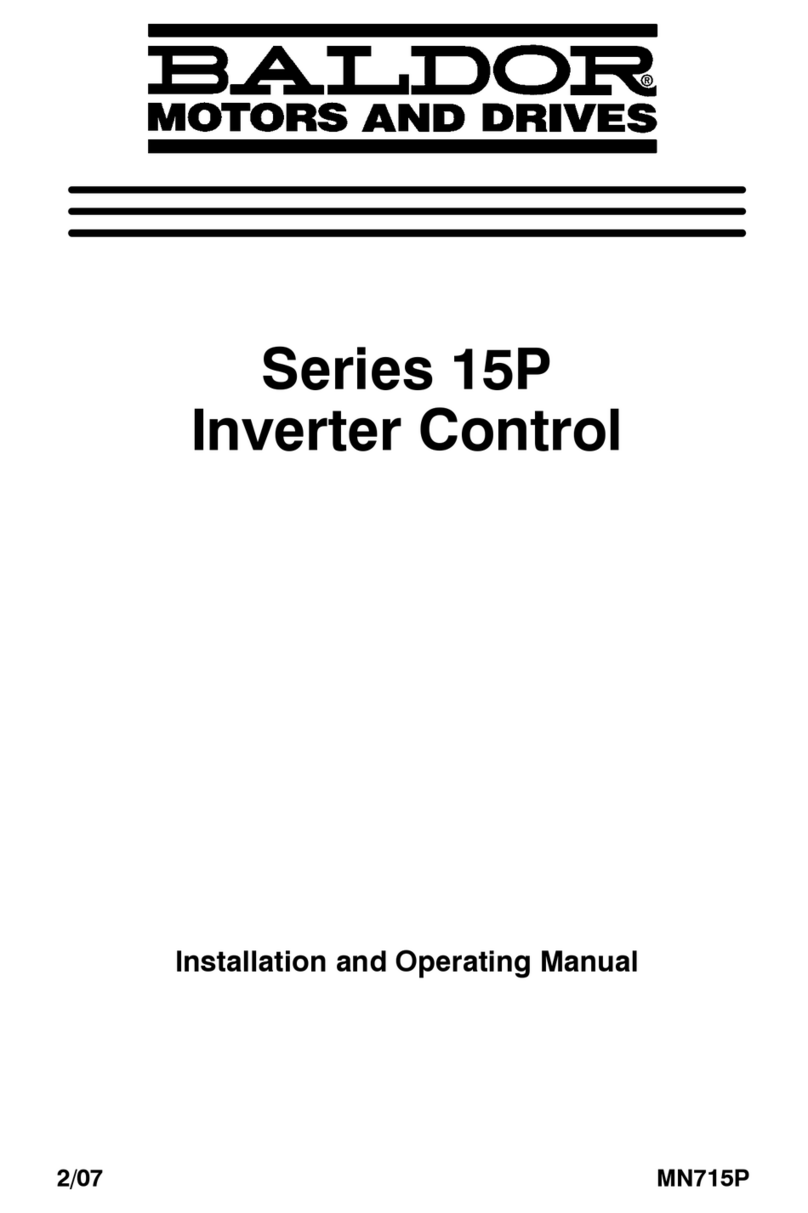
Baldor
Baldor 15P Series User manual
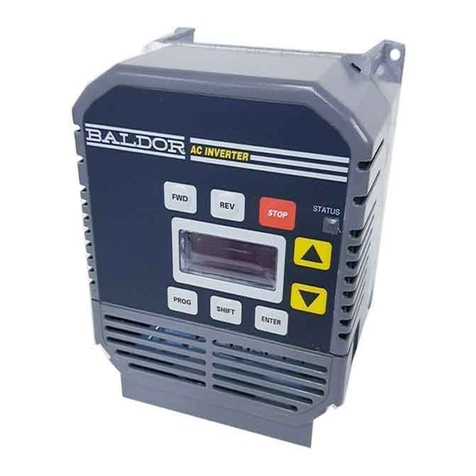
Baldor
Baldor Series 10 User manual
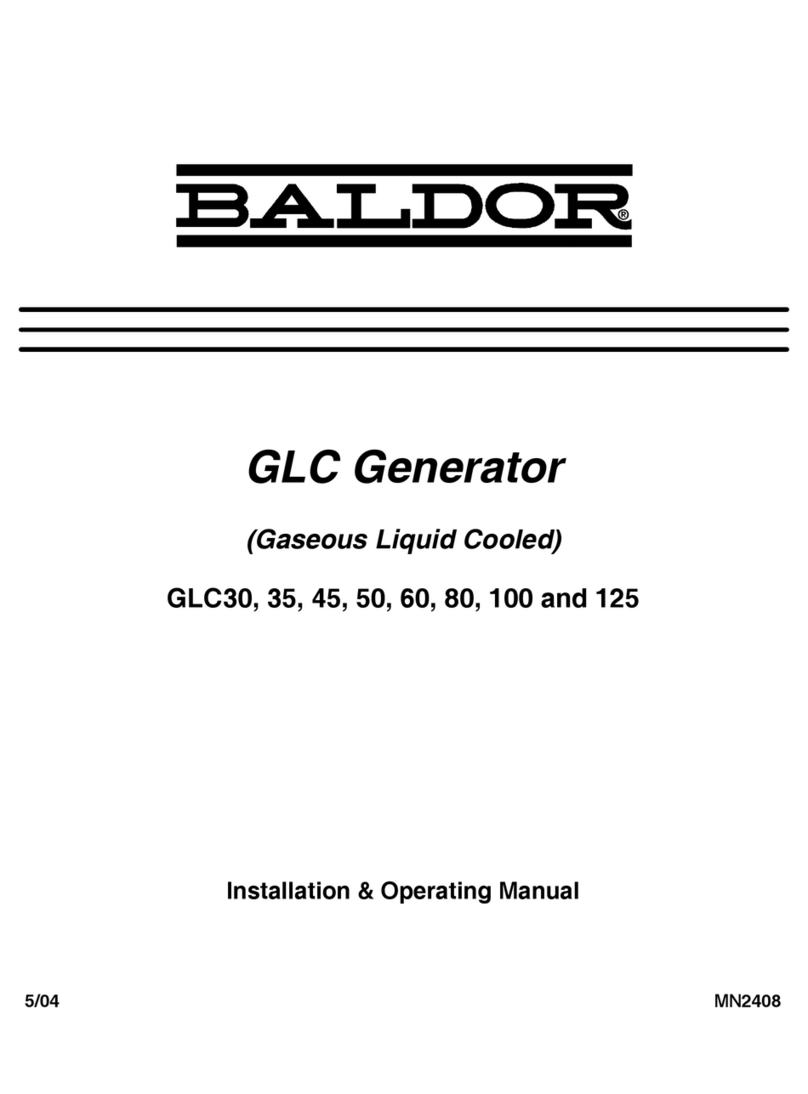
Baldor
Baldor GLC30 Installation instructions
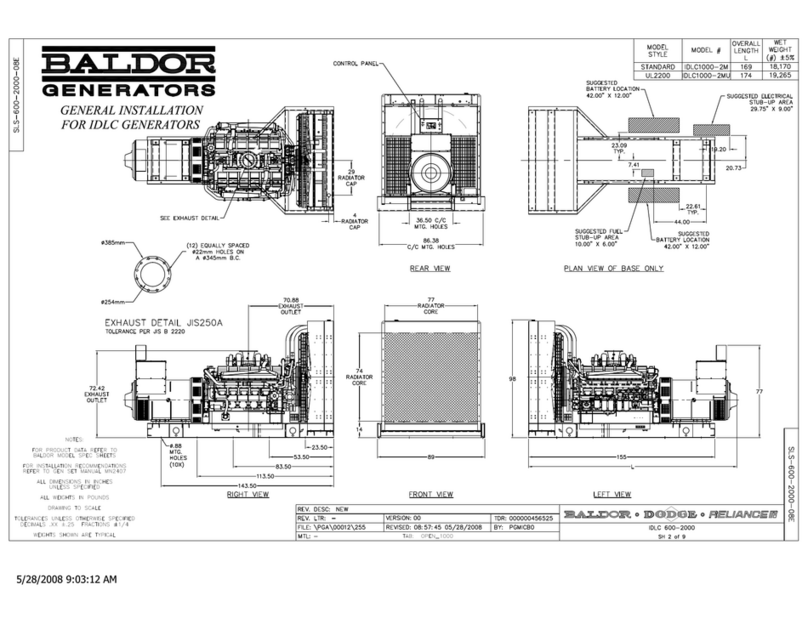
Baldor
Baldor IDLC1000-2M User manual
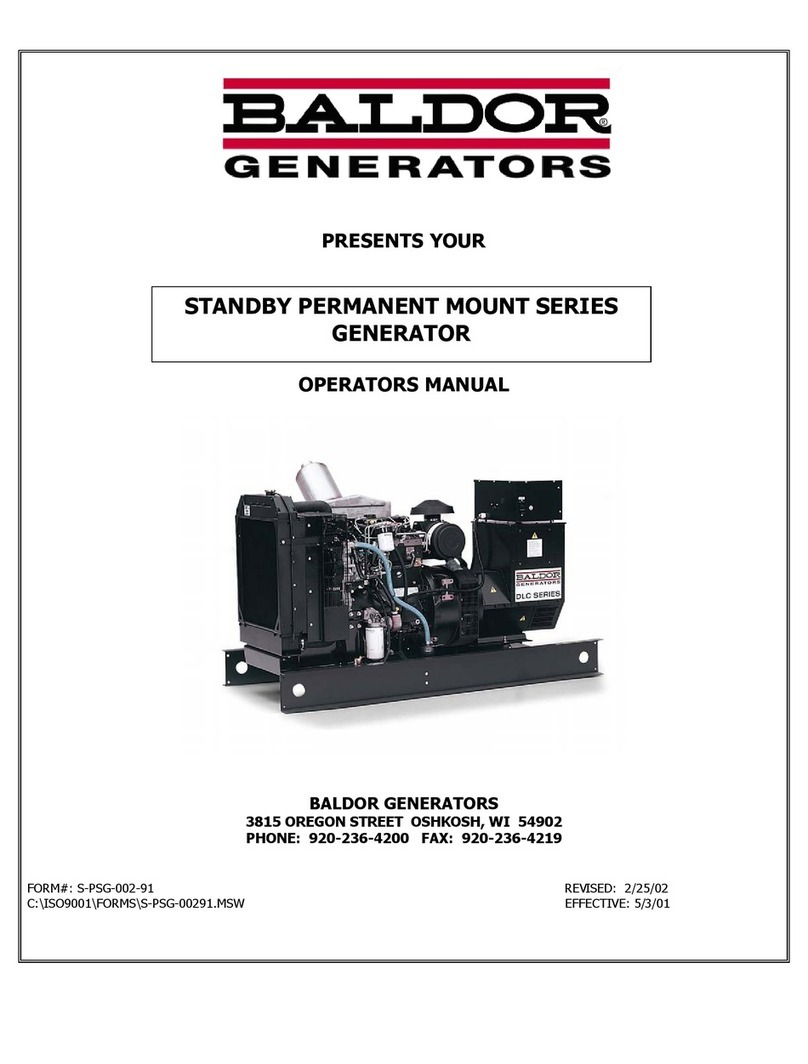
Baldor
Baldor STANDBY PERMANENT MOUNT SERIES User manual
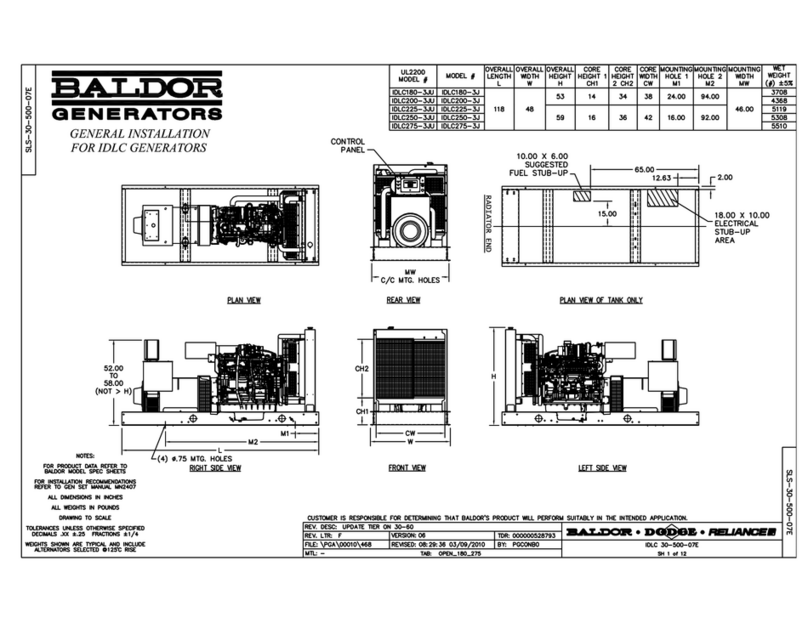
Baldor
Baldor IDLC180-3J User manual
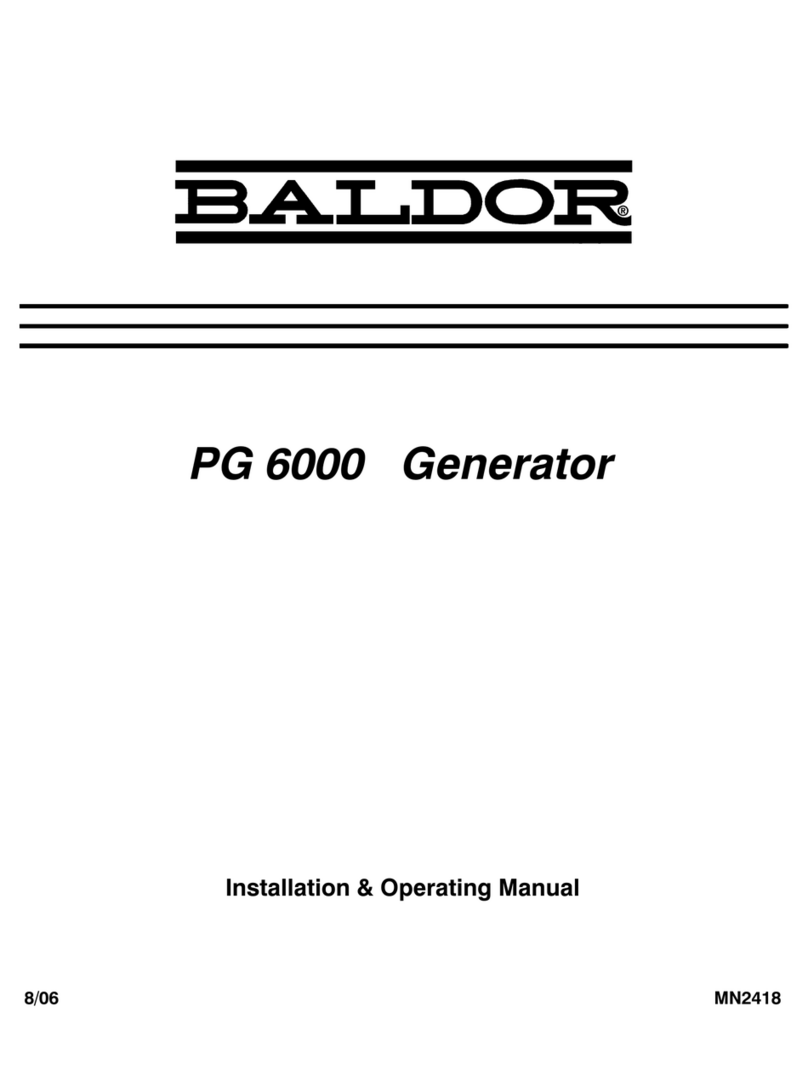
Baldor
Baldor PG 6000 Installation instructions

Baldor
Baldor IDLC100-3J User manual
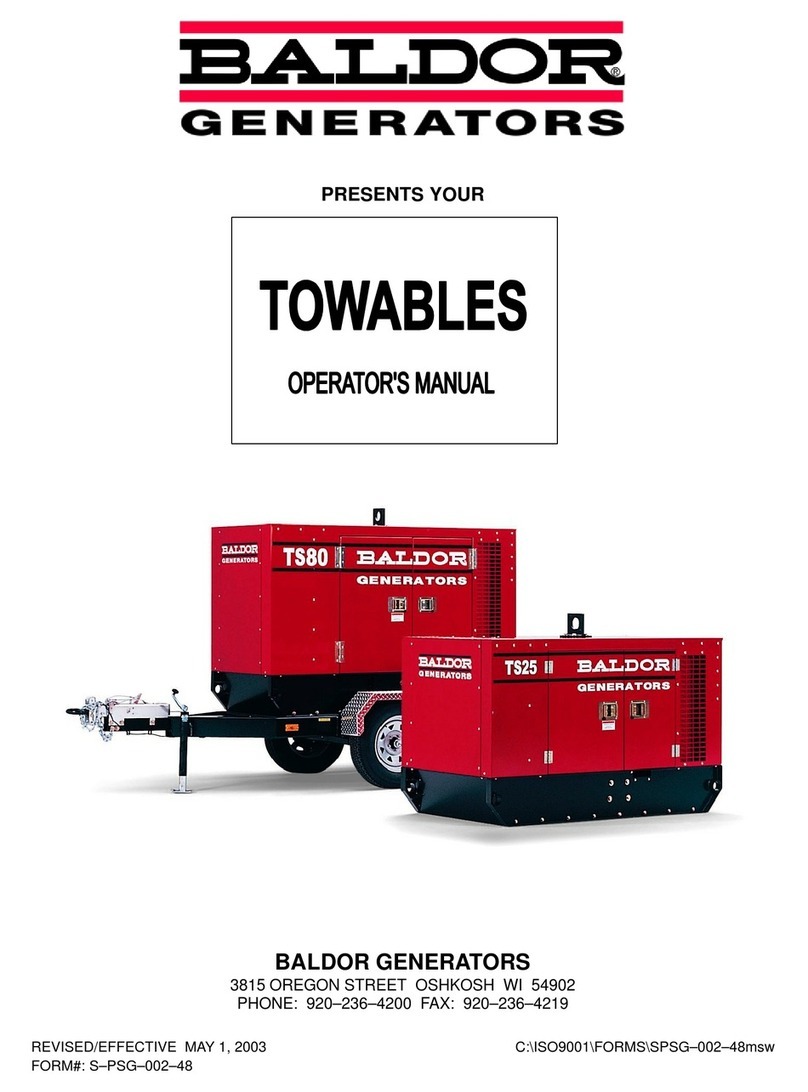
Baldor
Baldor TS25 User manual
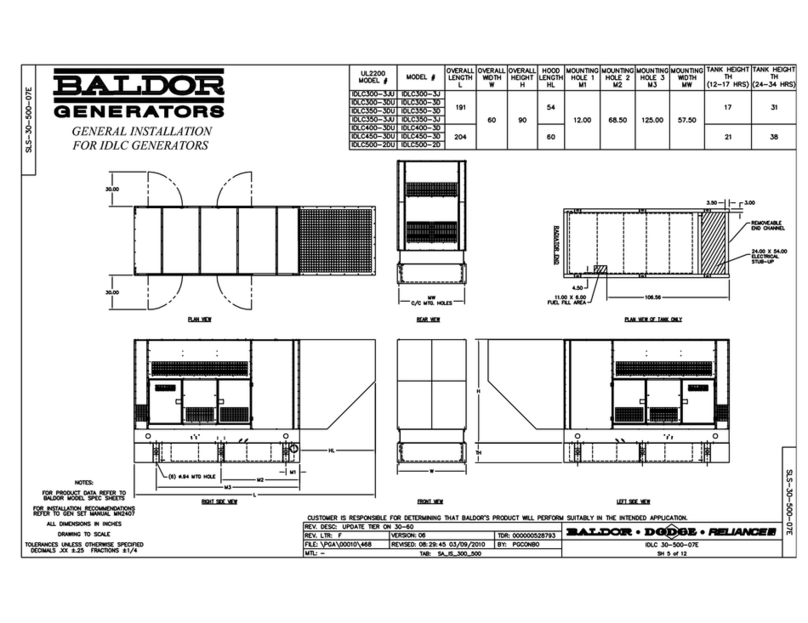
Baldor
Baldor IDLC300-3D User manual
Popular Inverter manuals by other brands
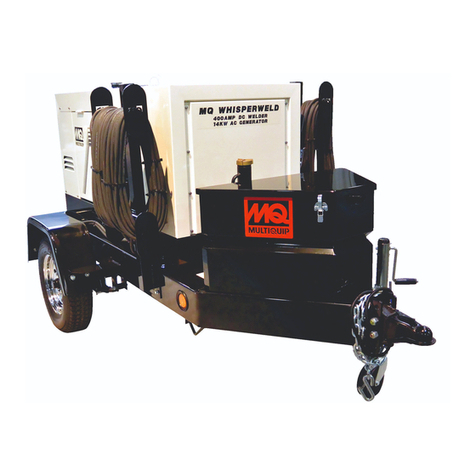
MULTIQUIP
MULTIQUIP DLW400ESA4 Operation manuals

YASKAWA
YASKAWA SOLECTRIA XGI 1500 Series manual
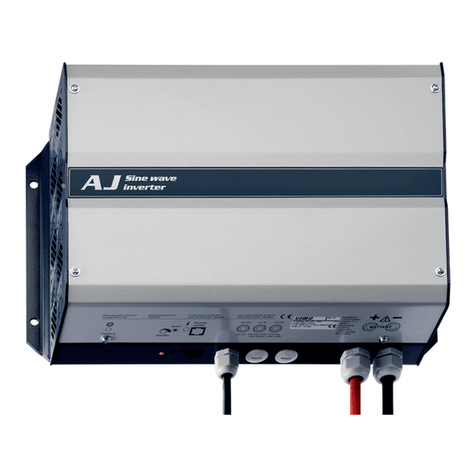
Bolanmu Energy
Bolanmu Energy AJ2100 quick guide

Mitsubishi Electric
Mitsubishi Electric FR-A520-2.2K instruction manual
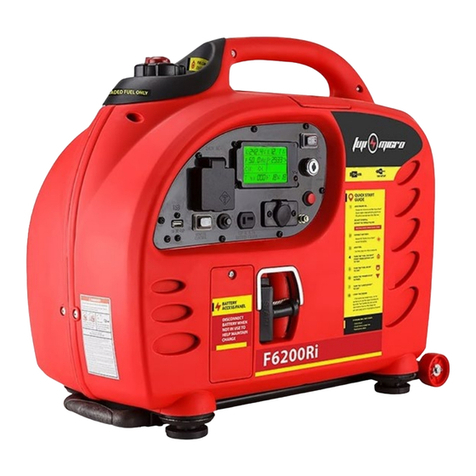
Fuji Micro
Fuji Micro Genforce Baumr-AG F5200Ri user manual

Kemot
Kemot PROsolar-800 owner's manual




